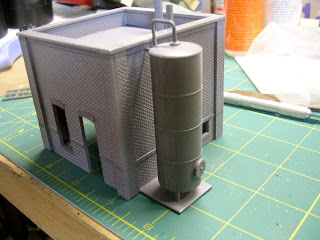



Over the weekend I worked on two elements still needed on the pig casting machine. I started building the crane. This is only partially necessary - the prototype was located next to a blast furnace cast house and used large ladles to collect the hot iron and then the crane lifted and tilted the ladles. My pig caster is receiving hot iron in bottle or ladle cars and thus technically there is nothing to lift, other than to maybe tilt a ladle. Never the less I am still modeling the full crane, slightly modifying it for the ladle cars I am using. The prototype drawings show limited details when it comes to the crane, so some of my modeling is freelanced in terms of exact layout,...etc.
The crane frame was built using modified 1/4" I beams and 3/16" channel. The wheels were made from sandwiches of punched circles with a brass axle. Drivetrains and motors were made and installed in what I think are logical locations. The main hoist sheaves are 43" grandt line parts.
The other structure I worked on is a small brick building that will serve as an office, storeroom, pump house and winch house for the pig casting machine. It was built using DPM modular components.





















 inus cold. It was also the first night in a while that I felt like going down to my workbench and modeling. I shift gears a little and started work on the high-line. For you non-steel people, the high-line is basically an elevated railroad used to fill many separate storage bins located beneath the high line with the essentials for fueling blast furnaces - iron ore, coke, and limestone. Under these bins is a sunken railroad track that has a scale car on it. This scale car receives materials from the bins and transports them to the skip hoist and thence into the blast furnace. I will be modeling pretty closely the prototype high-line used at Bethlehem Steel. On this line, the inner track is standard gauge and the outer is dual gauge (standard and 5') The wide gauge track was used for special cars used to transport the ore at Bethlehem. I am not sure if I am going to model dual gauge or just stick with standard on both tracks. I also won't be modeling the scale cars or line under the high-line. What you see is the first four, of very many bins that will make up my high-line. The bins are made of .040 styrene with wide flange beams between (3/16x 1) supported by 3/16 H-Columns. The structure still needs a framework to carry the rails, made from 5/16 I-beams.
inus cold. It was also the first night in a while that I felt like going down to my workbench and modeling. I shift gears a little and started work on the high-line. For you non-steel people, the high-line is basically an elevated railroad used to fill many separate storage bins located beneath the high line with the essentials for fueling blast furnaces - iron ore, coke, and limestone. Under these bins is a sunken railroad track that has a scale car on it. This scale car receives materials from the bins and transports them to the skip hoist and thence into the blast furnace. I will be modeling pretty closely the prototype high-line used at Bethlehem Steel. On this line, the inner track is standard gauge and the outer is dual gauge (standard and 5') The wide gauge track was used for special cars used to transport the ore at Bethlehem. I am not sure if I am going to model dual gauge or just stick with standard on both tracks. I also won't be modeling the scale cars or line under the high-line. What you see is the first four, of very many bins that will make up my high-line. The bins are made of .040 styrene with wide flange beams between (3/16x 1) supported by 3/16 H-Columns. The structure still needs a framework to carry the rails, made from 5/16 I-beams.